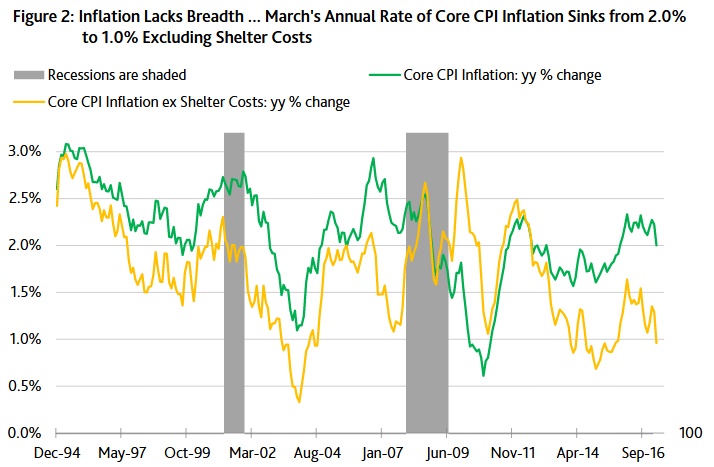Though US consumer price inflation is well contained, Fed policymakers cannot help but notice the potential threat to financial stability emanating from ongoing equity price inflation. As long as US equities become more richly priced relative to both current and prospective earnings, the Fed has more than enough reason to hike rates. A further swelling of the US equity bubble will increase Fed rate-hike risks.
Not too long ago, the high-yield bond spread swelled and the projected default rate soared. However, that intensification of credit stress would be quickly reversed mostly because debt repayment problems were largely confined to the oil and gas industry. In other words, the late 2015 and early 2016 worsening of corporate credit conditions lacked enough breadth to endanger both financial stability and the business cycle upturn.
Some still hold that inflation will come roaring back. For now, however, price inflation has been confined to housing, medical care, share prices, and industrial commodities (including energy). However, industrial commodity prices have softened of late. For example, Moody’s industrial metals price index was recently -7.2% under its latest 52-week high of November 28, 2016 and was down by a deep -31.1% from its record high of April 2011. Moreover, the price of WTI crude oil was recently off by -12.2% from its latest 52-week high of February 23, 2017.
Despite the plunge by the US unemployment rate from Q1-2012’s 8.3% to Q1-2017’s 4.7%, the accompanying annual rate of PCE price index inflation slowed from 2.5% to 2.0%. Moreover, even after excluding food and energy prices, core PCE price index inflation also decelerated from Q1-2012’s 2.1% to the 1.7% of Q1-2017.
Excluding food and energy products, the US core consumer price inflation has been skewed higher by shelter costs. For example, March’s 2.0% annual rate of core CPI inflation slowed to 1.0% after excluding a 3.5% annual jump by shelter costs that supply 42% of core CPI. And recent indications are that renters’ rent inflation may soon slow owing to an abundance of new housing units coming on line in some of the US’ largest metropolitan regions.
Today, some cite the recent climb by broad measures of price inflation as signaling the approach of significantly higher interest rates. With real GDP growth expected to sputter along in a range of 2% to 2.5% annually through 2018 how else can you explain expectations of a climb by the 10-year Treasury yield from its recent 2.35% to 3.3% by 2018’s final quarter?
Often, reference is made to a tighter labor market for the purpose of invoking a sense of danger regarding a possible imminent return of runaway price inflation. According to one highly-respected economics group, “ the U.S. economy has now reached full employment and is likely to overshoot meaningfully, a path that has often proven risky”.
Nevertheless, large numbers of labor force dropouts suggest that the unemployment rate may be overstating labor market tightness. For example, though the unemployment rate plunged by -3.6 percentage points from Q1-2012’s 8.3% to Q1-2017’s 4.7%, the ratio of payrolls to the working-age population rose by a smaller +2.2 points from Q1-2012’s 55.1% to Q1-2017’s 57.3%. Coincidentally, despite how 2005-2007 showed a much higher 59.5% ratio of payrolls to the working-age population, by no means did any overheating by the labor market prove risky.
Put simply, the Phillips Curve is not what it used to be. A lower unemployment rate now supplies less of a lift to price inflation compared to the past. In fact, sometimes consumer price inflation slows notwithstanding a substantially lower jobless rate.

